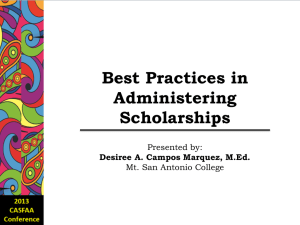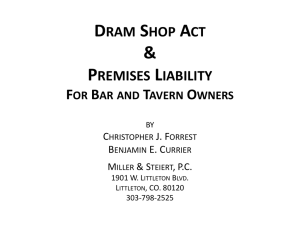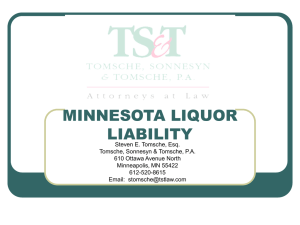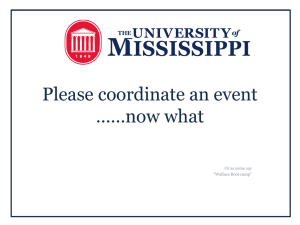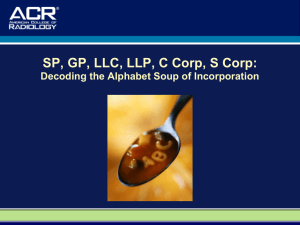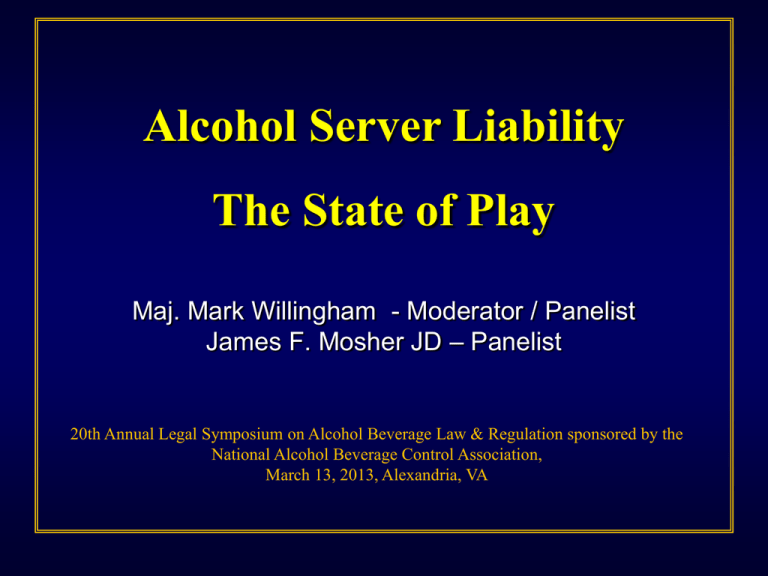
Alcohol Server Liability
The State of Play
Maj. Mark Willingham - Moderator / Panelist
James F. Mosher JD – Panelist
20th Annual Legal Symposium on Alcohol Beverage Law & Regulation sponsored by the
National Alcohol Beverage Control Association,
March 13, 2013, Alexandria, VA
News Flash:
Government to issue new
alcohol warning labels
that go beyond that required
for tobacco
New Alcohol Warning Labels
The consumption of alcohol may
create the illusion that you are
tougher, smarter, faster and
better looking than most people.
New Alcohol Warning Labels
The consumption of alcohol may
create the illusion that you are
tougher, smarter, faster and
better looking than most people.
The consumption of alcohol may
make you think you are
whispering
when you are not.
New Alcohol Warning Labels
The consumption of alcohol may
create the illusion that you are
tougher, smarter, faster and
better looking than most people.
The consumption of alcohol may
make you think you are
whispering
when you are not.
The consumption of alcohol may
cause you to think you can sing.
New Alcohol Warning Labels
The consumption of alcohol may
create the illusion that you are
tougher, smarter, faster and
better looking than most people.
The consumption of alcohol may
make you think you are
whispering
when you are not.
The consumption of alcohol may
cause you to think you can sing.
The consumption of alcohol may
cause you to tell your friends
over and over again that you love
them.
New Alcohol Warning Labels
The consumption of alcohol may
create the illusion that you are
tougher, smarter, faster and
better looking than most people.
The consumption of alcohol may
cause you to tell your friends
over and over again that you love
them.
The consumption of alcohol may
make you think you are
whispering
when you are not.
The consumption of alcohol may
make you think you can logically
converse with members of the
opposite sex without spitting.
The consumption of alcohol may
cause you to think you can sing.
New Alcohol Warning Labels
The consumption of alcohol may
create the illusion that you are
tougher, smarter, faster and
better looking than most people.
The consumption of alcohol may
cause you to tell your friends
over and over again that you love
them.
The consumption of alcohol may
make you think you are
whispering
when you are not.
The consumption of alcohol may
make you think you can logically
converse with members of the
opposite sex without spitting.
The consumption of alcohol may
cause you to think you can sing.
The consumption of alcohol may
leave you wondering what the hell
happened to your underwear.
New Alcohol Warning Labels
The consumption of alcohol may
create the illusion that you are
tougher, smarter, faster and
better looking than most people.
The consumption of alcohol may
cause you to tell your friends
over and over again that you love
them.
The consumption of alcohol may
make you think you are
whispering
when you are not.
The consumption of alcohol may
make you think you can logically
converse with members of the
opposite sex without spitting.
The consumption of alcohol may
cause you to think you can sing.
The consumption of alcohol may
leave you wondering what the hell
happened to your underwear.
The consumption of alcohol may lead you to think people
are laughing WITH you.
The Truth as I often see it.
“I’ve never been drunk, but often I’ve been
over served.”
George Gobel (1919 – 1991)
Time for Confession
“Forgive me Father, for I have overlooked a valuable tool.”
Confession
Criminal
Second degree misdemeanor
Administrative
$250 - 1,000 fine, if that. Truly a cost of doing
business.
Confession
I have come to recognize that there is a third
motivator – or tool – to drive responsible alcohol
retailing practices.
Confession
The Civil Justice System
Consider how a judgment of $70 Million, $7
Million, or even $700,000 can affect the future
behaviors of both the offending retailer and
others in the market.
Civil Justice System
The third leg of the proverbial three-legged stool.
Criminal
Administrative
Civil Action
How is the Civil Justice
System Used in This Venue
Dram Shop or
Commercial Host Liability
A phrase based on a unit of measure popular in
Victorian times,
Approximately 1/8th of an ounce in our
vernacular,
Synonymous with a prohibition on the overservice of alcohol to a patron or guest.
What is Dram Shop Liability?
Tort liability
What is Dram Shop Liability?
Tort liability
Holds retailers responsible for alcohol-
related harms caused by a patron
What is Dram Shop Liability?
Tort liability
Holds retailers responsible for alcohol-
related harms caused by a patron
Who was illegally served alcohol
because the patron was either
What is Dram Shop Liability?
Tort liability
Holds retailers responsible for alcohol-
related harms caused by a patron
Who was illegally served alcohol
because the patron was either
intoxicated (“adult liability”) or
What is Dram Shop Liability?
Tort liability
Holds retailers responsible for alcohol-
related harms caused by a patron
Who was illegally served alcohol
because the patron was either
intoxicated (“adult liability”) or
Underage (“underage liability”)
What is Dram Shop Liability?
Tort liability
Holds retailers responsible for alcohol-
related harms caused by a patron
Who was illegally served alcohol because
the patron was either
intoxicated (“adult liability”) or
Underage (“underage liability”)
Or habitually addicted at the time of
service.
What is Dram Shop Liability?
Dram Shop Liability or Commercial Host
Liability can be established by statute or by
application of common law
“New” Common Law Requirements re:
Duty of Care
Old Common Law Rule: Alcohol servers have no
duty to protect public from actions by their
underage and intoxicated patrons.
New Common Law Rule: This duty does exist
because the resulting harm is foreseeable and
the patrons’ actions are not superseding causes
of the harm.
“New” Common Law Requirements –
Evidentiary Requirements
•
Alcohol was served to a minor or
visibly/obviously intoxicated adult. AND
“New” Common Law Requirements –
Evidentiary Requirements
•
Alcohol was served to a minor or
visibly/obviously intoxicated adult. AND
• The server acted negligently using the
“reasonable person” standard AND
“New” Common Law Requirements –
Evidentiary Requirements
•
Alcohol was served to a minor or
visibly/obviously intoxicated adult. AND
• The server acted negligently using the
“reasonable person” standard AND
• Negligent service contributed
substantially to plaintiff’s harm.
Why Commercial Host Liability?
40% - 50% of alcohol-related vehicle
crashes originate in retail
establishments.
Drivers who Drove after Binge
Drinking Were Coming From:
54.3%
Bars/clubs/restaurants
32
Driving after Binge Drinking
54.3%
Bars/clubs/restaurants
27.7% reported consuming 10 or more
drinks before driving
33
Driving after Binge Drinking
54.3%
Bars/clubs/restaurants
27.7% reported consuming 10 or more
drinks before driving
35.7%
Private residences
34
Driving after Binge Drinking
54.3%
Bars/clubs/restaurants
27.7% reported consuming 10 or more
drinks before driving
35.7%
Private residents
10.0%
Elsewhere
“Drinking in bars and restaurants is strongly associated with binge
drinking and with alcohol-impaired driving among U.S. adults who
report binge drinking.”
Source: Driving after Binge Drinking, Am J Prev Med. 2009 37(4):314-20
35
Underage alcohol harm
Alcohol is the most commonly used drug among young
people.
In 2010, there were approximately 10 million underage
drinkers between the ages of 12 and 20 in the U.S.; 6.5
million of whom report binge drinking.
Underage alcohol harm
Alcohol is also a key factor in the leading causes of
death among 12 to 20 year olds: unintentional injuries,
homicide, and suicide.
Every day, 4,500 young people in the U.S. start drinking,
and every year we lose 4,700 young people because of
alcohol use.
Why Commercial Host Liability?
The Community Guide and literature reviews by NIAAA
and NHTSA have found:
Commercial host liability was associated with a
substantial reduction in alcohol problems
For example, a median reduction of 6.4 percent in
alcohol-related motor vehicle crashes.
Why Commercial Host Liability?
The Community Guide and literature reviews by NIAAA
and NHTSA have found:
Commercial host liability was associated with a
substantial reductions in alcohol problems (a
median reduction of 6.4 percent in alcohol-related
motor vehicle crashes)
However -
Why Commercial Host Liability?
The Community Guide and literature reviews by NIAAA
and NHTSA have found:
Commercial host liability was associated with a
substantial reductions in alcohol problems (a
median reduction of 6.4 percent in alcohol-related
motor vehicle crashes)
Legislation that limited the scope of commercial
host liability may undercut these positive effects
Why Commercial Host Liability?
Commercial host
liability substantially
raises the stakes
for violating laws
and encourages
adoption of
Responsible
Beverage Service
practices.
Judgment = $716 Million
A convenience store sold alcohol
to a minor… The minor got drunk
and crashed his car …
http://www.myfoxtampabay.com/story/18433300/for-selling-alcohol-to-minor
States by the numbers – Adult
As of January 1, 2011:
21 States and DC recognized liability without
major restrictions.
16 imposed restrictions.
13 did not recognize Dram Shop liability
States by the numbers – Underage
As of January 1, 2011:
28 States and DC recognized liability without
major restrictions.
16 imposed restrictions.
13 did not recognize Dram Shop liability
States by the numbers – RBS Defense
As of January 1, 2011:
6 States had a Responsible Beverage Service
defense by statute.
Statutory Limitations
Statutory Limitations on Commercial Host
Liability:
Restrict who may sue or be sued
Restrict the actions that lead to liability
Require higher standards of care
Require additional elements of proof of retailer
negligence
Limit recovery (damage caps)
“Joint but not several” liability – retailer may only be
responsible for its share of the harm.
Evidentiary Restrictions Applied
to Dram Shop Liability
RBS Affirmative Defense
Some states have an RBS Affirmative
Defense which provides:
A retailer will not be held liable if it
establishes that RBS (Retailer
Beverage Service) practices were in
effect at the time of the service to a
minor or intoxicated adult.
Model RBS Affirmative Defense
RBS practices include:
Training staff on:
Checking ID’s
Identifying intoxicated patrons
Slowing & cutting off drink service
No price promotions or other practices that encourage
intoxication
Adequate staffing and monitoring
Source: NIAAA, 1985
To many people, these Statutory
Limitations represent special interest
legislation.
They are perceived as harmful because
they reduce the deterrent effect of the
policy thereby reducing the likelihood that
retailers will adopt RBS practices at least
because of this motivation.
Responsible Beverage Service Defense: 2011
WA
MT
ME
ND
VT
MN
OR
NH
MA
ID
WI
SD
NY
WY
RI
MI
CT
PA
IA
NJ
NE
NV
OH
IL
UT
DE
IN
CO
MD
WV
KS
CA
MO
VA
KY
DC
NC
TN
AZ
OK
AR
NM
SC
MS
AL
GA
TX
LA
FL
Legend
States that recognize an RBS defense
AK
HI
States that do NOT recognize an RBS defense
How do the Courts establish
that the retailer acted in a
Reasonable and Prudent
Manner – in a non-negligent
manner?
By Applying Reasonable
Standard of Care.
What is Reasonable Standard of Care?
From where does it come?
Is there widespread agreement about it?
In tort law
a Standard of Care is
the degree of prudence and caution
required of an individual
under a duty of care.
Clear standards exist in
Medicine
A standard of care in the medical profession is
generally recognized as a treatment guideline
based on scientific evidence and collaboration
between medical professionals involved in the
treatment of a given condition.
Clear standards exist in other
Professions
A professional standard of care is generally
recognized to be the standard that would be
exercised by a reasonably prudent professional
in that particular line of work.
But do these clear standards
exist in the alcoholic beverage
industry?
Clearly, the beverage licensee
is under a duty of care.
Clearly, the beverage licensee
is under a duty of care.
Each state in the nation has made a public policy
decision to license alcoholic beverages
Among other issues, beverage alcohol, when
used as directed, presents a risk to the drinker,
those the drinker may harm, and society.
And should only be sold and served as
authorized by law.
How are reasonable
standards of care
established?
Where are these standards
found?
Professional Standards
Medical Boards, Academies establish the
appropriate medical standards.
Bar Associations establish appropriate standards
for the practice of law.
Even in my field, state Police Officer Standards
and Training establishes standards of care for
law enforcement officers as well as performance
guidelines based on academic evidence and
professional collaboration among professional
associations.
Legal action is vested with
each individual state.
Standards of care, while
largely similar from state, are
unique to each venue.
Reasonable standards of care
are expressed in part by:
Regulators
State laws and rules which codify the degree of
prudence and care expected by a beverage
retailer.
Regulators
State laws and rules which codify the degree of
prudence and care expected by a beverage
retailer.
Many regulatory agencies provide reference
documents for beverage retailers that express
agency expectations.
Regulators
State laws and rules which codify the degree of
prudence and care expected by a beverage
retailer.
Many regulatory agencies provide reference
documents for beverage retailers that express
agency expectations.
Many regulatory agencies have created training
programs that express agency expectations.
Regulators
State laws and rules which codify the degree of
prudence and care expected by a beverage
retailer.
Many regulatory agencies provide reference
documents for beverage retailers that express
agency expectations.
Many regulatory agencies have created training
programs.
Regulators may express opinions.
Regulators
All of which establish reasonable standards of care
in Commercial Host civil action.
These are what a reasonable and prudent
beverage retailer should do under the
circumstances.
Regulators
Regulators have the opportunity to expand these
reasonable standards of care through the
development and production of materials,
training programs, and findings that support
responsible alcohol retailing.
Laws and rules alone cannot possibly explain
everything a reasonable and prudent retailer
should do to prevent alcohol related harms.
Regulators
Regulators have the opportunity to expand these
reasonable standards of care through the
development and production of materials,
training programs, and findings that support
responsible alcohol retailing
The materials created and provided by regulators
have tremendous standing in establishing
reasonable standards of care for retailers.
Equally Importantly
These Regulatory actions and statements which
establish reasonable standards of care for civil
lawsuits …
Equally Importantly
These Regulatory actions and statements which
establish reasonable standards of care for civil
lawsuits …
also drive the implementation of these standards
throughout the industry. National, state, or
regional chains are examples.
State Industry Associations
Develop and publish guidelines
Present training programs
National Training Programs
ServSafe
TIPS
TAM
Etc.
Industry members themselves
Written and oral policies,
Alcohol service practices,
Employee and management training,
Management systems,
And risk assessment and risk abatement
practices
Industry members themselves
This is especially relevant in recognizing that
multi-state chains normally utilize one standard
for their business operation even for their
operation in states without dram shop laws.
Professional or lay person standard?
Is the reasonable standard of care in the service
of beverage alcohol based on the view of an
ordinary person or based on that of a
professional, well trained, well managed, and
motivated bartender or server?
Professional or lay standard?
A professional standard of care is more than the
care required of ordinary people.
Professional or lay standard?
Does this suggest that the reasonable and
prudent standard for an alcoholic beverage
industry member in detecting signs of
impairment, for example, should be higher than
the expected observations and recognition of
intoxication by a reasonable and prudent
layperson?
Professional or lay standard?
Should bartenders be expected to recognize
behaviors associated with intoxication at a lower
BAC level than an ordinary patron?
Professional or lay standard?
Does that affect the reasonable standards of
care for the industry?
Standards of Intoxication
For example, what is the appropriate standard for
obvious or visual intoxication?
What is the appropriate standard?
0.08 g%
Knee walking drunk?
A couple chapters into the novel?
Three sheets to the wind?
Has Sold his Senses?
Schnockered?
Toasted?
Seen the Devil?
Hammered?
Legless?
Standards of Intoxication
What is the appropriate standard?
And through whose eyes are these observations
made?
Standards of Intoxication
I believe that in large part the reasonable
standards of care which have been
intentionally or inadvertently established
are those which represent levels of intoxication
clearly at least twice that of the presumptive limit
for impaired driving.
Standards of Intoxication
Most states use ambiguous language such as
noticeable, visual, obvious intoxication without
defining those terms.
Other states use language to try to define those
standards which may be equally ambiguous.
Standards of Intoxication
New Mexico, the only state that I know of with a
scientific-based BAC level in their law creates a
rebuttable presumption that a patron was
obviously intoxicated when served if he/she has
a BAC of 0.14 or higher within an hour after
leaving the bar.
Yet, this standard does not apply to civil Dram
Shop actions.
Standards of Intoxication
What is the presumptive limit for the impaired
operation of a motor vehicle in the 50 states?
Standards of Intoxication
What is the presumptive limit for the impaired
operation of a motor vehicle in the 50 states?
The answer is 0.08 g%.
Standards of Intoxication
What is the presumptive limit for the impaired
operation of a motor vehicle in the 50 states?
The answer is 0.08 g%.
But if you reflect on dram shop laws you will see
that there is neither statutory language or case
law that parallels the standard imposed for
impaired driving.
Standards of Intoxication
I recognize that the inquiry for a DUI case is
fundamentally different than the inquiry for a
dram shop case.
Standards of Intoxication
I recognize that the inquiry for a DUI case is
fundamentally different than the inquiry for a
dram shop case.
I also recognize that imposing a 0.08 g%
standard for criminal, administrative, and/or civil
litigation may be too great a leap.
Standards of Intoxication
I recognize that as Jim points out the inquiry for a
DUI case is fundamentally different than the
inquiry for a dram shop case.
I also recognize that imposing a 0.08 g%
standard for criminal, administrative, and/or civil
litigation may be too great a leap at least in the
near-term.
But this discord represents a significant
challenge to the prevention of impaired driving
harms coming from beverage premises.
Police Physicians
1930s
DUI Standard and prevailing science for
observation of intoxication was 0.15 g%
Science has progressed since 1930, however,
the use of behaviors associated with intoxication
in the industry has not.
Private training company
Your patron is now visibly intoxicated and he will
have impaired reflexes.
He may drop cigarettes, spill drinks, knock over bar
stools, have slurred speech and stagger when he
walks.
His eyes may be bleary, Indicating he is seeing
double and feeling sleepy.
State Government Training
Bloodshot eyes or glassy eyes.
Flushed complexion
Disheveled hair or clothing
Staggering when walking
Unsteady on feet
Odor of alcohol about their breath
Uncoordinated actions or movements
Incoherent, garbled, or slurred speech
Boisterous, loud or profane language.
National Restaurant Chain
Physical reaction
Irregular or slurred speech
Poor coordination
Dazed, glassy look
Inability to complete sentences
Spilling food and drink
Inability to sit up properly
Swaying or drowsiness
Stumbling & walking into things
Time for a change
I believe that it is now time for Regulators,
Industry Members, Trainers, and others to
recognize that the science of intoxication has
moved on since 1930 and a standard for
discontinuing alcohol service should not still be
based on a 0.15 g% standard.
Questions – Discussions?

